Identifying fungi in commercial poultry caeca

Salmonella and Campylobacter continue to be the leading causes of foodborne illness. Billions of dollars have been spent on trying to control these pathogens, and a majority of the intervention strategies target these pathogenic bacteria within the gastro intestinal tract.
Many of the intervention strategies to prevent Salmonella and Campylobacter contamination in broiler production include the use of beneficial bacteria in the form of competitive exclusion or probiotics. Other organisms such as fungi and yeasts have been shown to have protective affects for controlling foodborne pathogens.
Role of fungi and yeasts not understood
Fungi and yeasts are consistent members of animal microflora that are poorly understood in relation to the production of poultry. Fungi have been associated with the onset of disease. However, there is evidence that fungi can provide protective effects, much like the bacterial populations. The scientific world is largely unaware of the role fungi and yeasts play in normal production parameters as fungi and yeast populations, plus their interactions with bacteria within the gastrointestinal tract of poultry, simply because they are not included in their studies.
Modulate immune responses
A better understanding of potentially beneficial fungi that could modulate immune responses under normal, stressed, and diseased conditions will provide useful data and potential alternatives to antibiotics. One problem that arises with working with fungal populations is the ability to identify the different genera/species, because relatively few laboratories focus on these populations.
Therefore, the goal of the present study was to record fungi recovered from commercial broiler and layer houses during production to develop a baseline of the fungal populations found in the caeca of poultry and to use an automated repetitive sequence-PCR as a diagnostic tool for identifying those fungi. The results will provide fungi background genera under commercial conditions which is important for investigating the impact of fungi on the gastrointestinal tract and on the health of poultry.












